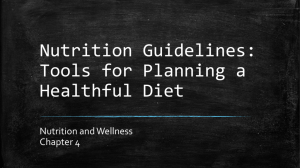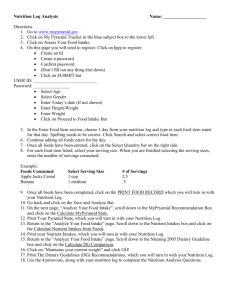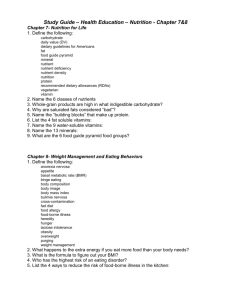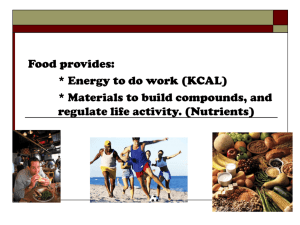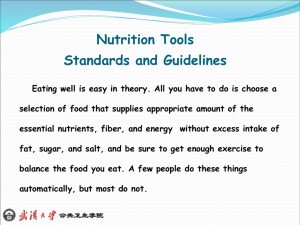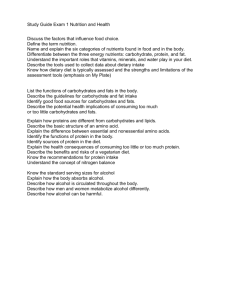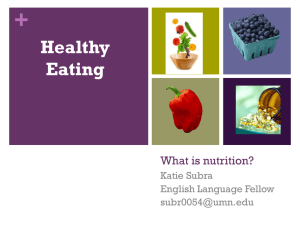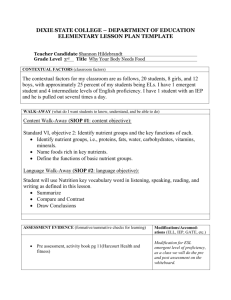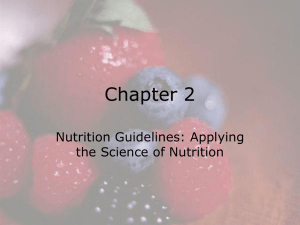Positive - Lectures For UG-5
advertisement
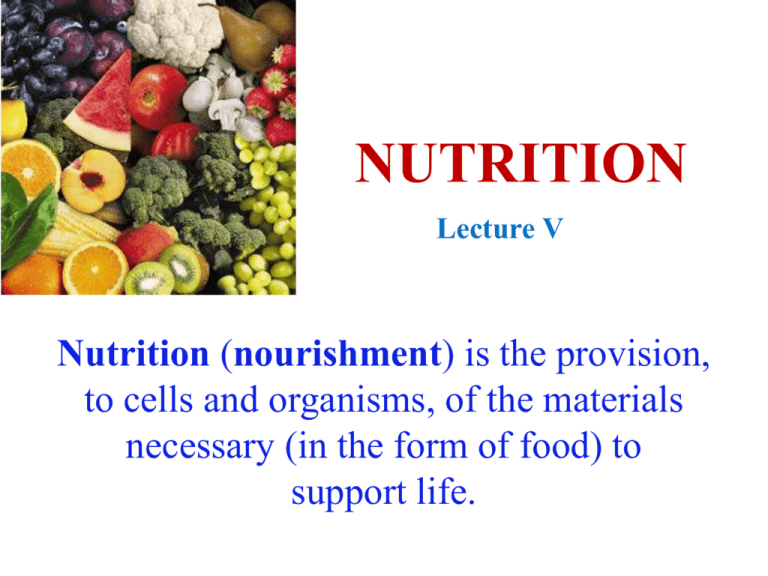
NUTRITION Lecture V Nutrition (nourishment) is the provision, to cells and organisms, of the materials necessary (in the form of food) to support life. Food Choices •Personal preference •Habit •Ethnic heritage or tradition •Social Interactions •Availability, convenience •Advertising: •Economy: They are within your means. •Emotional comfort: They can make you feel better for a while. •Body weight and image: Positive or negative associations: Positive: They are eaten by people you admire or they indicate status, or they remind you of fun. Negative They were forced on you or you became ill while eating them. Nutrients in Food Energy Yielding Nutrients Non Nutrients in Food Dietary Reference Intakes (DRI) A daily nutrient level estimated to meet the requirements of half the healthy individuals in a particular life stage and gender group. •Used to determine nutrient adequacy to reduce risk of chronic disease or other disorders. •Used to calculate RDA’s. DRI’s consist of four values •Estimated average requirements •Recommended dietary allowances •Adequate intakes •Tolerable upper limits Recommended Dietary Allowance (RDA) The average daily dietary intake level that is sufficient to meet the nutrient requirements of nearly all (97–98%) healthy individuals in a particular life stage and gender group. Adequate Intake (AI) The average daily nutrient intake level based on observed or experimentally-determined approximations or estimates of nutrient intake by a group (or groups) of apparently healthy people that are assumed to be adequate. Tolerable Upper Intake Level (UL) The highest average daily nutrient intake level likely to pose no adverse health effects to almost all individuals in the general population. As intake increases above the UL, the potential risk of adverse effects increases. Energy Recommendations Nutrient Recommendations •Estimates of energy and nutrient intakes apply to healthy people •Recommendations are NOT minimum requirements •Recommendations are NOT optimal for all people •Recommendations should be met by consuming a varied diet •Recommendations apply to average daily intakes •Each DRI category serves a unique purpose A nutritious diet has FIVE characteristics Adequacy: foods provide enough of each nutrient, fibre and energy Balance: not choosing one food/nutrient over another Calorie control: eating enough to maintain a healthy weight Moderation: foods high in fat, salt, or sugar can be eaten as part of a healthy diet if not eaten to excess. Variety: necessary in order to get all the nutrients one requires. How do we determine what we should eat? •Government agencies provide us with nutrition recommendations and guideline. •Recommendations based on scientific research •These recommendations are translated into food groups and serving sizes of foods Other foods Food Labels Who Speaks on Nutrition? Main Sources of nutrition information: •Product Labels •Radio/TV •Friends/relatives/ Colleagues •Magazines •Physicians •Dietitian/Nutritionist •Internet Fads, Frauds and Quackery Food Faddism is defined as the adoption of an unusual pattern of food behavior, that promotes short-term weight loss, usually with no concern for long-term weight maintenance (Fad Diets) Cabbage soup diet Grapefruit diet (Hollywood Diet) Quackery Is the promotion for profit of a medical scheme or remedy that is unproven or known to be false Who Falls Victim to Quackery People who are: •Unsuspecting, if it appear in the media, its TRUE •Believe in Magic, i.e., believe there is an easy solution •Desperate, i.e. those with serious health problems •Alienated, i.e. have a deep distrust of governments, medical profession, food companies, etc.

